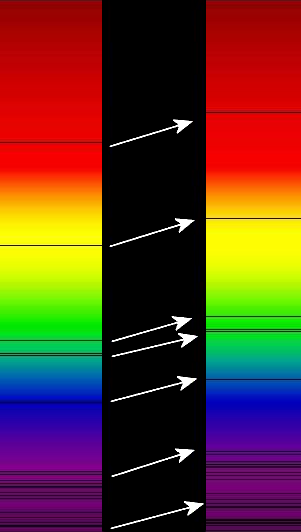Science, Religion, and the Big Bang (Minute Physics)
http://www.youtube.com/watch?v=q3MWRvLndzs
No Center (Everywhere Is The Center)
http://www.astro.ucla.edu/~wright/nocenter.html
http://www.astro.ucla.edu/~wright/infpoint.html
Misconceptions About the Universe
http://www.youtube.com/watch?v=XBr4GkRnY04
94% of the universe's galaxies are permanently beyond our reach
https://bigthink.com/starts-with-a-bang/universes-galaxies-unreachable/
Tests of Big Bang Cosmology
http://map.gsfc.nasa.gov/universe/bb_tests.html
The Big Bang Model is supported by a number of important
observations, each of which are described in more detail
on separate pages:
1. The expansion of the universe
http://map.gsfc.nasa.gov/universe/bb_tests_exp.html
Edwin Hubble's 1929 observation that galaxies were generally
receding from us provided the first clue that the Big Bang
theory might be right.
The Big Bang model was a natural outcome of Einstein's
General Relativity as applied to a homogeneous universe.
However, in 1917, the idea that the universe was expanding
was thought to be absurd. So Einstein invented the
cosmological constant as a term in his General Relativity
theory that allowed for a static universe.
In 1929, Edwin Hubble announced that his observations of
galaxies outside our own Milky Way showed that they were
systematically moving away from us with a speed that was
proportional to their distance from us. The more distant the
galaxy, the faster it was receding from us. The universe was
expanding after all, just as General Relativity originally
predicted!
Hubble observed that the light from a given galaxy was
shifted further toward the red end of the light spectrum the
further that galaxy was from our galaxy.
The specific form of Hubble's expansion law is important:
the speed of recession is proportional to distance. Hubble
expressed this idea in an equation - distance/time per
megaparsec. A megaparsec is a really big distance
(3.26 million light-years).
The expanding raisin bread model illustrates why this
proportion law is important. If every portion of the bread
expands by the same amount in a given interval of time, then
the raisins would recede from each other with exactly a
Hubble type expansion law.
In a given time interval, a nearby raisin would move
relatively little, but a distant raisin would move
relatively farther - and the same behavior would be seen
from any raisin in the loaf. In other words, the Hubble law
is just what one would expect for a homogeneous expanding
universe, as predicted by the Big Bang theory.
Moreover no raisin, or galaxy, occupies a special place in
this universe - unless you get too close to the edge of the
loaf where the analogy breaks down.
2. The abundance of the light elements H, He, Li
http://map.gsfc.nasa.gov/universe/bb_tests_ele.html
The Big Bang theory predicts that these light elements
should have been fused from protons and neutrons in the
first few minutes after the Big Bang.
3. The cosmic microwave background (CMB) radiation
http://map.gsfc.nasa.gov/universe/bb_tests_cmb.html
The early universe should have been very hot. The cosmic
microwave background radiation is the remnant heat leftover
from the Big Bang.
These three measurable signatures strongly support the
notion that the universe evolved from a dense, nearly
featureless hot gas, just as the Big Bang model predicts.
From Wikipedia
http://en.wikipedia.org/wiki/Big_Bang
http://apod.nasa.gov/apod/ap060323.html
 Energy Level Within Atomic Structure
Energy Level Within Atomic Structure
 Spectroscopy 101 - Types of Spectra and Spectroscopy
https://webbtelescope.org/contents/articles/spectroscopy-101--types-of-spectra-and-spectroscopy
From Wikipedia - Spectral Lines
http://en.wikipedia.org/wiki/Spectral_line
From Wikipedia - Spectral Lines (Continuous)
Spectroscopy 101 - Types of Spectra and Spectroscopy
https://webbtelescope.org/contents/articles/spectroscopy-101--types-of-spectra-and-spectroscopy
From Wikipedia - Spectral Lines
http://en.wikipedia.org/wiki/Spectral_line
From Wikipedia - Spectral Lines (Continuous)
 From Wikipedia - Spectral Lines (Emission)
From Wikipedia - Spectral Lines (Emission)
 From Wikipedia - Emission Spectra
http://en.wikipedia.org/wiki/Emission_spectrum
From Wikipedia - Spectral Lines (Absorption)
From Wikipedia - Emission Spectra
http://en.wikipedia.org/wiki/Emission_spectrum
From Wikipedia - Spectral Lines (Absorption)
 From Wikipedia - Absorption spectroscopy
http://en.wikipedia.org/wiki/Absorption_spectrum
From Wikipedia - Doppler Effect
http://en.wikipedia.org/wiki/Doppler_effect
From Wikipedia - Redshift
From Wikipedia - Absorption spectroscopy
http://en.wikipedia.org/wiki/Absorption_spectrum
From Wikipedia - Doppler Effect
http://en.wikipedia.org/wiki/Doppler_effect
From Wikipedia - Redshift
 sam.wormley@icloud.com
sam.wormley@icloud.com
Energy Level Within Atomic Structure
Spectroscopy 101 - Types of Spectra and Spectroscopy https://webbtelescope.org/contents/articles/spectroscopy-101--types-of-spectra-and-spectroscopy From Wikipedia - Spectral Lines http://en.wikipedia.org/wiki/Spectral_line From Wikipedia - Spectral Lines (Continuous)
From Wikipedia - Spectral Lines (Emission)
From Wikipedia - Emission Spectra http://en.wikipedia.org/wiki/Emission_spectrum From Wikipedia - Spectral Lines (Absorption)
From Wikipedia - Absorption spectroscopy http://en.wikipedia.org/wiki/Absorption_spectrum From Wikipedia - Doppler Effect http://en.wikipedia.org/wiki/Doppler_effect From Wikipedia - Redshift
sam.wormley@icloud.com